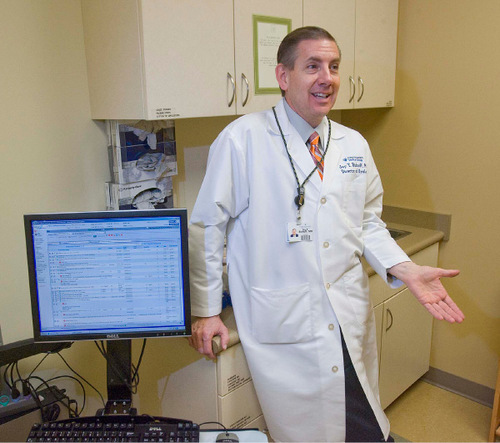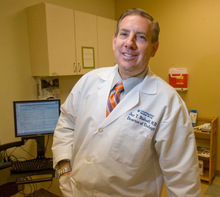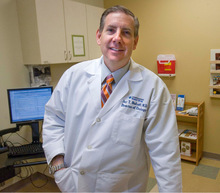This is an archived article that was published on sltrib.com in 2010, and information in the article may be outdated. It is provided only for personal research purposes and may not be reprinted.
His interest was academic at first.
Jay Bishoff had heard stories and seen data charting the alarming rise of fatal overdoses linked to prescription pain pills. New to his post as chief of urology at Intermountain Medical Center, he set out in 2009 to see "if we in urology were contributing to the problem."
Midway through his study, the quest became personal when he learned a teenage relative had become dependent on narcotics.
Now, armed with evidence that urologists send surgery patients home with too many painkillers — sometimes double the amount required — Bishoff is urging specialists, from orthopedists to cardiologists, to reduce their doses.
His study will be published in the February issue of the Journal of Urology and was presented earlier this year at the annual meeting of the American Urologic Association. It is changing how Intermountain Medical Center's pharmacy dispenses and disposes of narcotics. And it may offer one promising remedy to the supply side of the nation's prescription-drug problem — one that could be achieved without sweeping legislation or new industry regulations.
"This a multipronged problem with no quick and easy solution," said Bishoff. "We, all of us including doctors, need to wake up and start talking about it. Ignorance is what gets us all in trouble."
—
Millions of pills unused • Rates of prescription drug abuse have leveled off as states have ramped up monitoring of controlled substances and taught people how to safely use and dispose of them. But it remains one of the nation's leading drug problems.
And little has been done to stem the tide of narcotics prescribed for acute pain after an injury or medical procedure.
There is no good national data on which specialties overprescribe, how frequently they do it or by how much.
But Bishoff estimates that last year, Intermountain Healthcare urologists were responsible for nearly 1 million unused pain pills "floating around the community."
That's just one department in one hospital system, excluding private physician offices, the University of Utah hospitals and clinics or other major chains like MountainStar or IASIS, he says.
Bishoff surveyed urology patients over three months at two Intermountain hospitals and University Hospital.
With Cory Bates, a urology resident at the U., he pulled a random sample of adult patients. Called two weeks after surgery, about half, or 275 of them, agreed to interviews.
They were asked: How many narcotics did you get, how many did you take, how many did you have left and what did you do with them?
"My partners didn't know about this," said Bishoff. "We didn't want them to change their prescription habits."
Bishoff and Bates grouped patients by procedure, ranging from a scope of the bladder and urethra to major surgeries, such as kidney removal.
For all but major surgeries, the average number of pain pills prescribed was fairly constant. But the range from surgeon to surgeon was broad.
More importantly, about half – 40 percent to 58 percent – of all pills went unused, even though the vast majority of patients reported being satisfied with their pain control. Very few patients were told how to properly dispose of the leftovers. And 91 percent stored them at home.
"The perception is that people who misuse narcotics are doctor shopping," said Bishoff. "And while some do, there's an easier way. You get them from a friend's, neighbor's or relative's medicine cabinet."
—
Slide into addiction • Bishoff knows this firsthand, having talked to teens at the treatment center that his young relative checked into last year. These "good kids" started experimenting with pain relievers left over from a parent's shoulder surgery or hernia repair, developed a dependency and then turned to street heroin, which is cheaper and easy to conceal, he said.
"Adolescents in our state don't perceive prescription-drug use as illegal or bad," Bishoff said. "They see a drug addict as the person [who] goes to bad parts of Utah to buy marijuana and heroin."
It's a trajectory confirmed by years of research.
"We know access, availability and perceptions of harm have an enormous amount to do with whether a teen chooses to use these drugs," said Sue Foster, a vice president and director of policy research at the National Center on Addiction and Substance Abuse at Columbia University.
Studies also show the spike in prescription drug abuse, which began in the '90s, mirrored a jump in the rate of prescriptions sold, Foster said.
At that time, "you had patients who were being undertreated for pain, especially women and minorities. And there was a huge attempt to get doctors to recognize pain and treat it appropriately, which is a good thing," said Foster. "But, meanwhile, doctors weren't being trained on addiction, how to recognize it and respond to it."
—
Slowing the flow • Bishoff's study is preliminary and will need to be validated with larger patient populations.
"But it's probably reflective of what happens at large," said his research partner Bates. The duo have been lecturing at hospitals and found physicians receptive to slowing the flow of narcotics.
"I personally have cut in half what I might normally prescribe," Bates said, noting very few patients pester him for refills.
Bishoff said the pharmacy at Intermountain Medical Center produced an educational brochure to send home with narcotics. And there's talk of starting a take-back program, inviting patients to return unused pills.
His research is yet another example of data-driven medicine, which Intermountain Healthcare encourages its employees to pursue.
But physicians can be wary of evidence-based medicine, especially when it comes to dictating something as subjective as pain management.
"It's so different for each person, depending on what's broken and how acute the injury, and whether the person is pain-tolerant or not," said Erin Johnson, manager of "Use Only as Directed," a public-awareness effort led by the state Health Department.
The program issued guidelines for treating chronic and acute pain, but stopped at urging doctors to give patients only the required amount of pills.
"We decided not to dictate doses, but to let physicians use their judgment," said Johnson.
Most physicians use sound judgment, Johnson believes. But she said it's not uncommon for them to prescribe as many pills as a patient's insurance plan will cover, to avoid additional appointments and co-payments.
Bishoff argues data can bring greater precision to medical care. He hopes others replicate his research and that mounting evidence spurs professional groups, such as the Society of Orthopaedic Medicine or Society of Thoracic Surgeons, to offer procedure-specific prescribing guidelines.
"When I was a resident," he said, "no one ever told me, 'Doctor Bishoff, when you do a cystoscopy, you should give the patient 12 tablets of Oxycontin or Vicodin.' "
Narcotics abuse, by the numbers
Almost every day, someone in Utah dies from a prescription drug overdose, and 81 percent are legally prescribed a painkiller the year prior to their death.
71 percent of patients who are prescribed narcotics keep leftovers at home.
78 percent of heroin users start with legally prescribed opioids. In 2006, pain relievers surpassed marijuana as the drug most often tried for the first time.
80 percent of the world's narcotics supply is used by the United States, which accounts for 5 percent of the world's population.
5 million Americans use narcotics non-medically; 60 percent obtain them from a friend or relative for free.
Sources: Utah Department of Health and National Survey on Drug Use and Health, 2008







